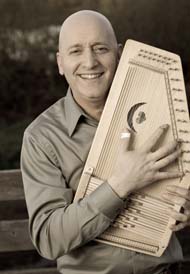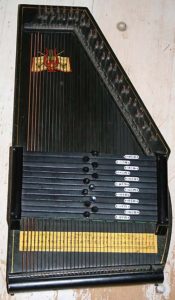
The Autoharp is a musical stringed instrument having a series of chord bars attached to dampers which, when depressed, mute all the strings other than those that form the desired chord. Despite its name, the autoharp is not a harp at all, but a chorded zither.
Autoharp History
There is debate over the origin of the autoharp. A German immigrant in Philadelphia by the name of Charles F. Zimmermann was awarded US patent 257808 in 1882 for a design for a musical instrument that included mechanisms for muting certain strings during play. He named his invention the “autoharp”. Unlike later autoharps, the shape of the instrument was symmetrical, and the felt-bearing bars moved horizontally against the strings instead of vertically. It is not known if Zimmermann ever commercially produced any instruments of this early design. Karl August Gütter of Markneukirchen, Germany, had built a model that he called a “Volkszither” which most resembles the autoharp played today. Gütter obtained a British patent for his instrument circa 1883-1884. Zimmermann, after returning from a visit to Germany, began production of the Gütter design in 1885 but with his own design patent number and catchy name. Gütter’s instrument design became very popular and Zimmermann has often been mistaken as the inventor.

Trademark
The term “autoharp” was registered as a trademark in 1926. The word is currently claimed as a trademark by U.S. Music Corporation, whose Oscar Schmidt division manufactures autoharps. The USPTO registration, however, covers only a “Mark Drawing Code (5) WORDS, LETTERS, AND/OR NUMBERS IN STYLIZED FORM” and has expired.
In litigation with George Orthey, it was held that Oscar Schmidt could only claim ownership of the stylized lettering of the word autoharp, the term itself having moved into general usage. As a consequence, for instance, Autoharp Quarterly is able to register its own mark using the word autoharp in its generic sense, and Orthey instruments (and other manufacturers) can market their instruments as “autoharps”.
Construction
Modern autoharps have 36 or 37 strings, although some examples with as many as 47 strings, and even a rare 48-string model exists. They are strung in either diatonic (1, 2 or 3 key models) or chromatic scales. Standard models have 15 or 21 chord bars, or buttons, available, a selection of major, minor, and dominant seventh chords. These are arranged for historical or systemic reasons, for example:
Eb Bb F C G D A
F7 C7 G7 D7 A7 E7 B7
Ab Bb7 Cm Gm Dm Am Em
Although the autoharp is often thought of as a rhythm instrument for playing chordal accompaniment, modern players can play melodies on the instrument. Diatonic players are able to play fiddle tunes by using open-chording techniques, “pumping” the damper buttons while picking individual strings. Skilled chromatic players can perform a range of melodies.
Diatonically strung single key instruments from modern day luthiers such as Jim Woods (Evoharp builder) and Sparrowharp builder Pete Daigle, are known for their lush sound. This is accomplished by doubling the strings for individual notes. Since the strings for notes not in the diatonic scale need not appear in the string bed, the resulting extra space is used for the doubled strings, resulting in fewer damped strings. Two-and three-key diatonics compromise the number of doubled strings to gain the ability to play in two or three keys, and to permit tunes containing accidentals which could not otherwise be rendered on a single key harp. A three-key harp in the circle of fifths, such as a GDA, is often called a festival or campfire harp, as the instrument can easily accompany fiddles around a campfire at a festival in their favored keys.
Since diatonic harps have less key choices than chromatic harps, designers offer alternate or “color chords” such as minor sevenths and suspended chords.
